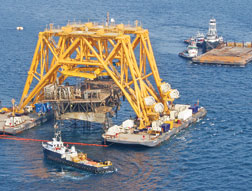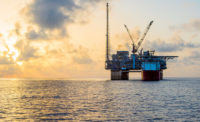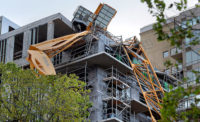 Versabar Corp
|
Diagonally opposing universal joints let Bottom Feeder’s trusses move independently while keeping the load stable. |
Elegant engineering is solving the sloppy problem of raising offshore oil and gas platforms swept by the 85-ft waves of hurricanes Ivan, Katrina and Rita to the Gulf of Mexico’s bottom.
Using trusses, four winches and four blocks counterbalanced and stabilized catamaran-like on two barges, Houston-based Versabar Corp.’s Bottom Feeder can lift a platform topsides weighing up to 1,800 tons from 400 ft depths in less than an hour. Versabar is a specialized lifting company.
“It’s amazing,” says Melanie Labiche, a structural engineer with the U.S. Minerals Management Service (MMS), which oversees oil and gas leasing, after observing one of the company’s first lifts. “It’s flawless, from what I can tell.”
Versabar has lifted six platforms topsides from the Gulf’s bottom, and has a contract to lift four more in the spring.
Jon Khachaturian, Versabar’s president and CEO, developed the Bottom Feeder about two years ago. It was built by Gulf Marine Fabricators, Aransas Pass, Texas, for $30 million. On its first tryout this summer, it successfully lifted three topsides in three weeks.
| |
MMS requires that topsides be removed from the water or turned into reefs for fish. Until the 2005 hurricanes, which toppled 117 platforms, equipment like the Bottom Feeder was not needed. “Toppled structures are new to the Minerals Management Service,” Labiche says. “They are new to the industry.” The cost of removing a platform is probably about 10 times more than what companies had planned to spend to decommission a well, she says.
As of August, five of the platforms have been turned into reefs, including Chevron’s $250-million Typhoon platform in 2,000 ft of water.
Versabar won’t say how much it costs a company to use the Bottom Feeder, but Khachaturian has said that it’s roughly half the cost of other means of removal. The platform can be removed in a single piece, or dismantled by divers and cranes. Operators typically don’t like the risk or cost of sending divers down so deep. And lifting a platform with a standard crane is difficult because the platform’s weight and center of gravity are unknown, Khachaturian says.
The Bottom Feeder consists of two sets of 110-ft-tall trusses mounted on two, 250-ft-long, 72-ft-wide barges. A single truss leg on each barge is joined to the vessel with a bidirectional universal joint. A second bidirectional universal joint is located diagonally on the other barge. The remaining legs of the trusses on each barge are connected by a fixed hinge. This design allows the barges to move independently in an “X” and “Y” direction, rather than as a rigid piece.
From the top of the connected trusses hang four 12-part blocks with 21⁄4 -in. wire rope, each capable of lifting 1,000 tons. The blocks work with four diesel-powered hydraulic winches. Each block can be operated independently, in tandem with another block, or together as a unit with the three other blocks. That gives the operator, using a joystick, the option of lifting one corner at a time to minimize the suction effect of the mud on the bottom.
The Bottom Feeder is certified to 4,000 tons, but Versabar will attempt to lift only platforms it knows to be about 1,800 tons or less because the weight of blocks and suction can be as much as 1,800 tons, says Chris Steinmetz, Versabar’s general manager. The device’s limit is about 400 ft.
For a lift, the Bottom Feeder is fixed in place with winches in an eight-anchor spread. The blocks are lowered into the water, connected to pelican hooks previously welded to the platform, and the platform is slowly lifted, typically in 45 minutes, Steinmetz says.



Post a comment to this article
Report Abusive Comment